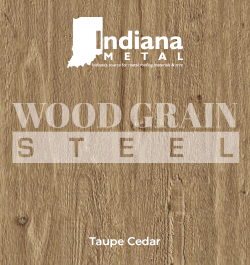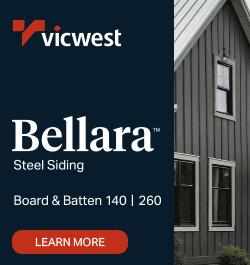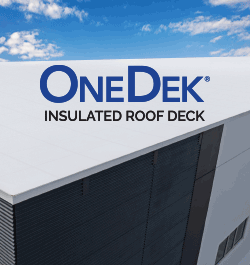UP TO THE MINUTE
Why the Life Span of Metal Roofing Outweighs its Cost

MCS Influencer Rob Haddock says that metal roofing has a service life of 60-plus years, a benefit that far outweighs its cost.
Editor's note: The following consists of a conversation between our Multimedia Manager Megan Ellsworth and S-5!'s Founder Rob Haddock. You can listen to the podcast or read the transcript below.
Megan Ellsworth: Hello, everyone. My name is Megan Ellsworth here at MetalCoffeeShop.com, and I'm back again for a May influencer response with Rob Haddock. Hi, Rob. How you doing?
Rob Haddock: I'm just fine as frog's hair, Megan. I hope you are too.
Megan Ellsworth: Doing well. Glad to be here with you. This month's topic is all about metal and being compared to other building materials, and the question is, when looking at the true cost of metal compared to other building materials, how does longevity, durability, and resilience factor into that conversation?
Rob Haddock: A whole bunch, if you're a smart buyer. But first, let's define the true cost of "metal," quote, unquote, compared to other building materials, other roofing materials, I assume you mean. We are talking about roofing, right?
Megan Ellsworth: Yes.
Rob Haddock: Generally speaking, and of course costs vary all over the place and all over the country geographically, as well as union versus non-union situations, and residential versus commercial, and so on and so forth. But generally speaking, metal is a premium cost over single plies and asphalt shingles of somewhere around 25 or 30%, as a rule. And as we both know, there are exceptions to every rule, but that's just kind of my 30,000-foot observation.
I have a guest house that a number of years ago had asphalt shingles on it, got hailed out, and the adjuster valued a re-roof at so many dollars, and I installed a metal roof within that dollar amount. So, he was appraising an asphalt shingle replacement. I used a metal replacement, and met the budget that he had established. I've been around the commercial and industrial space for a long time, and until COVID, so these numbers are pre-COVID, on a large commercial project, the cost of a TPO roof with insulation was in the range of two-and-a-half dollars, and metal was more like three or three-and-a-half dollars, so that's kind of the comparative cost.
But when you think about that, and you spoke about longevity, so let's tackle that one first. Metal standing seam, Galvalume steel, which is the lion's share of the metal roofing market, has been documented to have a service life of 65-plus years, and other metals can last even longer than that. Aluminum would be presumably longer, and copper and zinc and some of the natural metals. So, a metal roof, at the bottom end of the spectrum, has a service life of well over 60 years, and all the way up to 150 or 200 for some of the natural metals.
And so, when you think about that in terms of service life of other roof types that are, according to some, more traditional, that have a service life of 15 or 20 years at the most, generally speaking, again exceptions to every rule, then you're looking at roof replacement every 15 or 20 years or whatever it is. With metal, you're looking at a roof replacement after 60 or 70 or 80. So, when you look at it that way, and you can do all the math on current values and so on and so forth, but it makes an enormous amount of sense. So, when we talk about longevity, metal typically will have a service life of two, three, or even four times what other materials that are used would be.
When it comes to durability, metal can be engineered to resist essentially any wind speed you want to, all the way up to category four and five hurricanes, because it's an engineered product. And it is ... What's the word I want? It is stable in its behavior, in its mechanical behavior, so unlike a lot of other alternative materials, it's unaffected by UV. It's unaffected in essence by age, except perhaps for corrosiveness or corrosivity.
And so it is durable. It's just been proven that it's much more durable in hailstorm, so windstorm, hailstorm, firestorm. I'm sitting in the middle ... Where I built my new office is sitting on a burn scar. It was scarred during the Black Forest Fire of 2013, and it burned everything on this property to the ground.
Megan Ellsworth: Wow.
Rob Haddock: You can bet I've got a metal roof on, and most of my neighbors in this vicinity have also gone to metal, because of the threat of wildfire. So, this building is pretty much non-combustible. The wall finishes outside are metal, stone, and stucco, none of which are really combustible. The roof is a metal roof, so in terms of windstorm, firestorm, and hailstorm, I think it's undeniably the champion of the roofing industry. So, that pertains to durability.
Now when it comes to resilience, you'd have to tell me what you mean by that, other than long longevity and durability.
Megan Ellsworth: Yeah, I think you pretty much covered ... I mean, resilience would just be redundant at this point. But that is so interesting that your new office is on a burn scar, and you and all your neighbors have metal roofs. That just, I mean, like you said, that goes to show the durability of a metal roof and how everyone, not just you in the roofing industry, is believing that it'll be a safer option for those in wildfire areas.
Rob Haddock: Well, and another aspect is that metal is more friendly to solar installation. Solar is becoming a really big thing, roof-mounted solar, and metal is more conducive to solar applications, and that translates to lower costs of installing solar on a rooftop. And not to mention the fact that the average life of PV nowadays, solar photovoltaics, is in the range of 35 years, and there isn't another roof type out there, really, that will last for the entire service life of the solar. So, it makes an awful lot of sense to put solar on a metal roof, not as much on other roofs. The ROI is going to be different and you've got to factor in the removal of the solar to replace the roof and so on after so many years. So, we've built three new facilities in the last couple of years. They all have metal roofs and they all have been fitted with roof-mounted solar PV as well.
Megan Ellsworth: Wow, that's really cool. Dang. Yeah, I mean, just when you said, just the longevity of metal, I mean, that alone is enough to convince anybody, I think. 60, 70 years.
Rob Haddock: Well, the MCA, I initiated an industry-wide project starting back in 2010 to evaluate the real service life of Galvalume-coated steel, and that service life was demonstrated. This was done all over the country on 14 different building sites, on aged buildings, and we did a lot of lab testing and maths and so on and so forth. There's a full report on it published by the Metal Construction Association, but it has a service life demonstrable beyond the 60-year range, up closer to the 70-year range at minimum, in most normal environments.
US Steel notably has very recently really lit up the industry, because US Steel did some research, and they looked back into the warranty claims that they'd had. The whole Galvalume steel industry has had a warranty of 25 years, and it's a material warranty. US Steel just raised that to between 40 and 60, just depending upon the particulars of the coating and so forth. So US Steel at least, they're only one US producer, but they're a major one, and they've just raised their warranty limits, as I said.
Megan Ellsworth: Wow. That's fabulous. That's really good to hear, too. And just like for homeowners and building owners alike, the options are just getting wider and wider now. Any last words on this topic, on the durability, longevity of metal roofing?
Rob Haddock: No.
Megan Ellsworth: Okay.
Rob Haddock: It's a beautiful day.
Megan Ellsworth: Hey, yeah. Awesome. Well, this has been great, Rob.
Rob Haddock is the founder and CEO of S-5!. See his full bio here.




















Comments
Leave a Reply
Have an account? Login to leave a comment!
Sign In